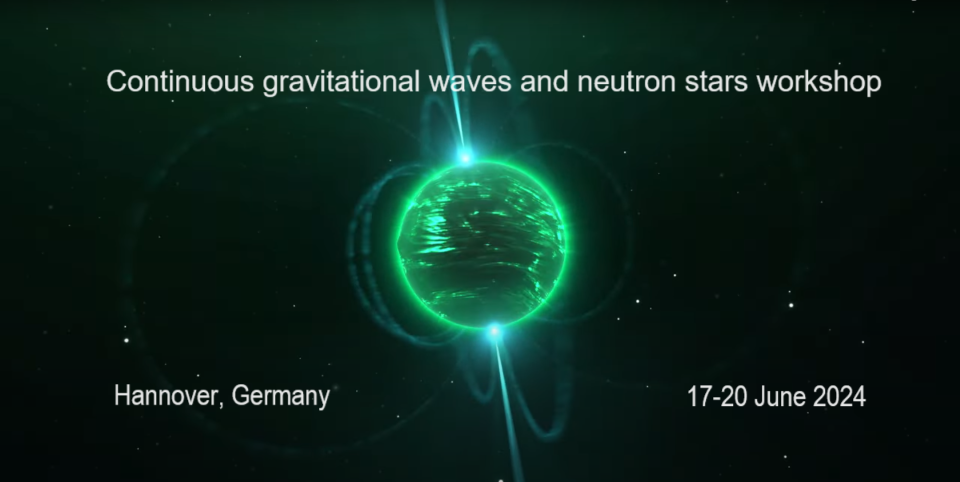I will describe the latest results on the modelling of gravitational wave emission from neutron stars, discussing both mountains and stellar oscillations. In the case of mountains, I review the latest results on both maximum mountains, and the mechanisms by which mountains might form in the first place. I will end by discussing the inverse problem, i.e. what we learn following a detection.
The spin of pulsars can be timed with exquisite precision. They are observed to spin-down steadily over long periods but once in a while, they can undergo a rapid and sudden increase in their spin, which is known as a glitch. For some cases, the glitch is followed by a post-glitch recovery. There are several models that predict the emission of continuous gravitational waves from glitches and...
In the next few decades a number of space-based gravitational wave detectors sensitive in the deci-Hertz band should be operational.
Among the main goals of such detectors are a number of "first detections" such as primordial gravitational waves, compact stellar mass inspirals and intermediate mass black hole mergers.
Interestingly enough we find no mention of Continuous Gravitational...
The Einstein Telescope (ET) is a proposed third-generation, wide-band gravitational wave (GW) detector which will have an improved detection sensitivity for low frequencies, leading to a longer observation time in the detection band and higher detection rate for binary neutron stars (BNSs). GWTC-3 detections have already constrained the merger rates of BNS with just two events, assuming that...
In the past decades, several neutron stars (NSs), particularly pulsars, with mass $M>2M_\odot$ have been observed. On the other hand, the existence of massive white dwarfs (WDs), even violating the Chandrasekhar mass limit, was inferred from the peak luminosities of type Ia supernovae. Hence, there is a generic question of the origin of massive compact objects. Here we explore the existence of...
The accurate modeling of rotating neutron stars and their observational signatures is fundamental to exploring the nuclear equation of state at high densities. However, modeling rapidly rotating neutron stars, especially their dynamical properties, becomes increasingly involved with rotation rate. This talk presents a set of novel universal relations that are valid even with high rotation...
To detect quasi-monochromatic gravitational wave radiation emitted by the non-symmetric rotating neutron stars requires a long observation time to distinguish it from the detector's noise. If, in addition, the signal is microlensed, the mass of the lens magnifies the signal amplitude, which aids in detection of these signals and in probing the physical nature of the lens as well as the source....
The observed spin frequency distribution of millisecond (ms) pulsars is a result of their current or previous spin evolution in the low-mass X-ray binary phase. Such a spin evolution depends on various physical aspects, such as binary evolution, disk-magnetosphere interaction, continuous gravitational wave emission, transient accretion, neutron star equations of state, etc. Thus, the...
In this talk, I will review the main properties of the galactic population of neutron stars, the so-called neutron star zoo. I will focus in particular on the subgroup of isolated stars, such as magnetars, X-ray dim isolated neutron stars (XDINS), and central compact objects in supernova remnants (CCOs).
I will also discuss how different neutron star populations are thought to be...
In the era of multi-messenger astrophysics, we are on the precipice of observing binary systems within our galaxy using gravitational waves in addition to traditional electromagnetism, in the advent of third generation gravitational wave detectors such as LISA. The joint messenger observations can bolster our detection ability of systems throughout our galaxy, providing an unprecedented...
The r-mode instability is among the most promising sources for continuous gravitational-wave emission from rotating neutron stars. However, our present understanding of these purely axial perturbations rely on Newtonian gravity and assume simplistic models of the nuclear matter. Moreover, calculations in general relativity suggest a continuous spectrum, posing challenges for...
Neutron stars provide a unique opportunity to study strongly interacting matter under extreme density conditions. The intricacies of matter inside neutron stars and their equation of state are not directly visible, but determine bulk properties, such as mass and radius, which affect the star's thermal X-ray emissions. However, the telescope spectra of these emissions are also affected by the...
The existence of massive white dwarfs (WDs), violating the Chandrasekhar mass limit, was inferred from the peak luminosities of type Ia supernovae. On the other hand, independent observations have suggested that WDs can have surface magnetic field upto 10^9 Gauss, which can be even more intense in the center. One of the interesting models to explain the existence of such massive WDs is to...

